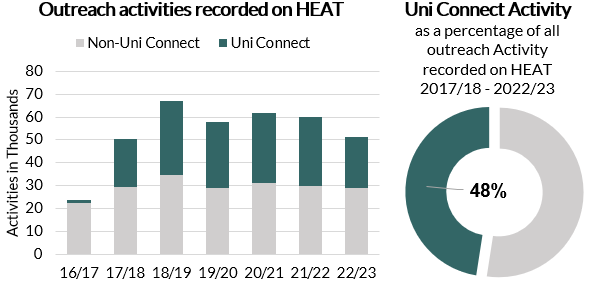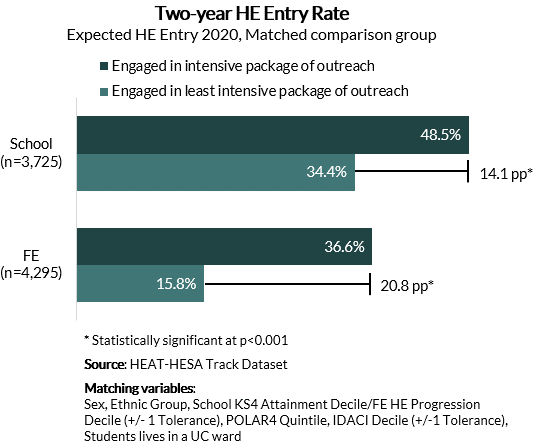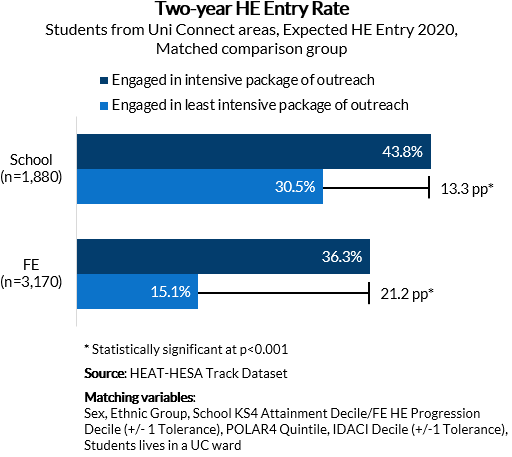Key Findings



Between 2017/18 and 2022/23, almost half of the outreach activities recorded on HEAT were delivered by, or in partnership with, Uni Connect partnerships.
Students who take part in an intensive package of Uni Connect activity consisting of at least eight contact hours are up to 21 percentage points more likely to enter higher education than a closely matched group of students who took part in less than three hours of Uni Connect outreach.*
The higher education entry gap is particularly pronounced for further education learners who live in Uni Connect target areas; those in receipt of an intensive package of Uni Connect activity were more than twice as likely to enter higher education than a closely matched comparison group.
* For the full definition of the different levels of outreach intensity used in this Report, please refer to the Methodology Section.
Introduction
On an annual basis, HEAT submits complete records for students who are expected to be ready to enter higher education (HE), and have given permission to be tracked, to the Higher Education Statistics Agency (HESA) for longitudinal tracking into the HE population. The latest HEAT-HESA Track dataset included students expected to enter HE in the 2021/22 academic year or earlier. This report presents the key findings from the latest HEAT-HESA Track dataset, in particular for 346,580 students who have taken part in outreach activities delivered by, and in partnership with, Uni Connect Partnerships.1
This report provides a summary of:
- The outreach engagement recorded by Uni Connect Partnerships using HEAT
- The impact of Uni Connect on HE Progression
An overview of the coverage of Uni Connect and volume of delivery since its launch is shown, before drawing on a quasi-experimental matched cohort design of tracked Uni Connect outreach participants expected to enter HE in 2020/21 to explore progression to HE within two years, by 2021/22.
Footnotes are listed at the end of this page.
Methodology
For the quasi-experimental matched cohort design, we compare outcomes of a group of students who participated in an intensive package of outreach to a closely matched comparison group of students who participated in none to minimal outreach. An intensive package of outreach is defined as ‘11+ hours of any activity and eight or more hours of a high intensity activity content (Summer School, HE Subject Insight, Mentoring, Skills & Attainment, Campus Visit)’. To be classed as ‘a least intensive package of outreach’ (i.e., none to minimal outreach), a student has received a maximum of one activity with low intensity content (General HE Information or Exhibition) or less than three contact hours overall.2
Comparison groups were created using case control matching in SPSS based on a set of matching variables available in the HEAT-HESA Track dataset. Matching variables were selected based on:
- Research on factors impacting HE entry
- Student characteristics likely to be related to risks concerning equality of opportunity3
- Data availability4
It should be noted that the HEAT-HESA Track dataset is considered secondary data, i.e., this data has already been collected by the Uni Connect partnerships using HEAT and additional data collection is not feasible. Therefore, key variables affecting HE progression such as student motivation and prior attainment5 could only be included using proxies. Despite these limitations, the HEAT-HESA Track dataset provides the largest longitudinal tracking dataset of Uni Connect outreach participants available.
Uni Connect Coverage

The majority of Uni Connect delivery is captured on HEAT with 25 out of 29 (over 86%) partnerships using HEAT as their chosen tracking service (Figure 1). We are therefore in a good position to examine delivery programme-wide.
Since its launch in late 2016/17, over 167,000 activities and over 1 million learners were recorded on HEAT in conjunction with Uni Connect activity.6 Since its first full delivery year, 2017/18, Uni Connect has accounted for nearly half of all outreach activities recorded on HEAT (Figure 2).

While Uni Connect activity delivery and student engagement saw an upward trend following the COVID-19 pandemic, the recent decrease in funding for Uni Connect is visible when looking at activities delivered and students engaged in the most recent academic year, 2022/23 (Figure 3).

Uni Connect impact on HE Progression
In this section, we explore the entry rates of Uni Connect participants who were expected7 to enter HE in 2020/21, and who did so by 2021/22. These learners will have had a maximum of three full years of engagement in Uni Connect activity (Table 1).8 Learners who took part in Uni Connect activity in earlier year groups are yet to be tracked into HE.
2016/17 |
2017/18 |
2018/19 |
2019/20 |
2020/21 |
2021/22 |
|
Cohort |
Cohort in Year 10 | Cohort in Year 11 | Cohort in Year 12 or FE equivalent |
Cohort in Year 13 or FE equivalent |
Cohort may enter HE by age 18 |
Cohort may enter HE by age 19 |
Uni Connect |
Starts in Summer 2017 |
Cohort engaged for 1 year max. |
Cohort engaged for 2 years max |
Cohort engaged for 3 years max. |
Table 1: Timeline of Participation in Uni Connect activity in expected HE progression
All Students engaged in Uni Connect outreach
First, we explore the HE Progression of all students engaged in Uni Connect activity, regardless of whether they live in an area targeted by the Uni Connect Programme.
Tracking school students engaged in an intensive package of Uni Connect outreach activities into HE shows that they were 14.1 percentage points more likely to enter HE than a closely matched comparison group of students who received little to no Uni Connect outreach (Figure 4). This gap, which was found to be statistically significant, suggests that participating in an intensive package of Uni Connect outreach while in school may have a positive impact on progression to HE within two years of being expected to enter.

Tracking FE students9 engaged in an intensive package of Uni Connect outreach activities into HE shows that they were 20.8 percentage points more likely to enter HE than a closely matched comparison group of FE students who received little to no Uni Connect outreach. The large gap between entry rates of FE students who participated in an intensive package of outreach to those who did not was found to be statistically significant and those in receipt of an intensive package of outreach in this subgroup were therefore more than twice as likely to enter HE than their counterparts in receipt of little to no outreach. This gap suggests that FE students may particularly benefit from participation in an intensive package of outreach.
Students in receipt of an intensive package of Uni Connect outreach from both types of institutions, schools and FE colleges, are more likely to progress to HE within two years than those in receipt of little to no Uni Connect outreach. This suggests that the Uni Connect Programme is contributing to reducing the gap in HE participation between the most and least represented groups by contributing to increased progression to HE of its outreach participants.
Students engaged in Uni Connect outreach who live in Uni Connect target areas
Secondly, we explore the impact of Uni Connect on the most disadvantaged students. These are learners who live in areas specifically targeted by the Uni Connect Programme due to their low HE progression rates.
Using the same closely matched comparison groups as above, the data shows that those school students in receipt of an intensive package of outreach, who live in a Uni Connect target area, were 13.3 percentage points more likely to enter HE than their peers in a closely matched comparison group living in Uni Connect target areas who received little to no Uni Connect outreach (Figure 5).

FE students who live in Uni Connect target areas and were in receipt of an intensive package of outreach were 21.1 percentage points more likely to enter than their peers in receipt of little to no Uni Connect outreach.
These findings suggest that outreach delivered by Uni Connect partnerships is effective in supporting those learners in the most disadvantaged areas, in line with the priorities of the Uni Connect programme, suggesting a contribution to increasing HE progression where it is needed the most.
Overall, it can be concluded that engagement in intensive Uni Connect activity has been beneficial to HE progression of both school and college learners and for both the overall cohort and for learners in target areas.
With learners who were in engaged in more than one year of Uni Connect activity pre-16 yet to be tracked into HE, we look forward to exploring the impact of even more sustained and progressive programmes, implemented over time, in future analyses.
Copyright: Higher Education Statistics Agency Limited 2023. Neither the Higher Education Statistics Agency Limited nor HESA Services Limited can accept responsibility for any inferences or conclusions derived by third parties from data or other information supplied by the Higher Education Statistics Agency Limited or HESA Services Limited.
1. A HEAT-HESA Track Impact Report specifically for students engaged in outreach recorded on HEAT by higher education providers is also available.
2. For more details, please refer to our paper on Classifying Packages of Outreach by their Levels of Intensity.
3. Informed by the Office for Students’ Equality of Opportunity Risk Register.
4. This analysis draws from student and activity data recorded on HEAT by all Uni Connect HEAT members. Large datasets like this are more likely to feature gaps and inconsistencies in data collection as well as data entry errors. Students where key variables were not available are not included in this quasi-experimental design due to the matching process not being able to proof sufficient similarity between the groups where data is missing, unknown, or unreliable.
5. Prior attainment for the cohort included in this report will be made available to us as part of an upcoming KS4-KS5-HESA Linked Dataset and we intend to update the analysis in this report using individual-level attainment data for matching.
6. HEAT is a live database and members can make changes to their data at any time. Therefore, monitoring figures presented in this report may differ from previously published figures due to retrospective changes made.
7. The expected HE entry year is either calculated based on date of birth or manually recorded by the HEAT member.
8. Learners who took part in Uni Connect activities may have also been in receipt of outreach activities outside of Uni Connect.
9. Students were classed as ‘FE’ if they participated in outreach while at a further education college.



